#Triassic fish fossil
Explore tagged Tumblr posts
Photo

Fossil Fish Tooth – Upper Triassic – Aust Cliff, Westbury Formation, Bristol UK – Genuine Specimen
Fossil Fish Tooth in Matrix – Upper Triassic – Aust Cliff, Westbury Formation, Penarth Group, Bristol, UK
This listing features an authentic fossil fish tooth preserved in matrix, originating from the iconic fossil-bearing bed at Aust Cliff, Bristol. This site is internationally recognised for its rich accumulation of fish, reptile, and coprolite remains from the Upper Triassic period, particularly within the Westbury Formation of the Penarth Group.
Geological & Scientific Context:
Locality: Aust Cliff, Bristol, UK
Stratigraphy: Westbury Formation, Penarth Group
Age: Upper Triassic (~205��210 million years ago)
Depositional Environment: A marginal marine estuarine or coastal lagoon setting with periodic anoxic conditions. These created ideal preservation conditions, capturing a moment in time from a biologically diverse late Triassic ecosystem.
Lithology: Laminated, organic-rich black mudstones with bone and tooth-rich concentrations
Fossil Description & Features:
The specimen displays a clearly defined fish tooth embedded within a natural matrix, offering a glimpse into the feeding anatomy of prehistoric fishes. Likely candidates for attribution include Saurichthys, Lepidotes, or Palaeoniscid fish—all of which are known from this formation.
Morphology:
Conical or lanceolate shape typical of piscivorous species
Smooth enamel surface, occasionally striated, with tapering to a fine point
Root occasionally visible, though often encased in matrix
Palaeontological Significance:
Teeth from this bed are essential in studying the evolution and dietary adaptations of early ray-finned fishes and predatory actinopterygians
The fossil record from Aust Cliff helps reconstruct the dynamics of Triassic vertebrate communities just before the major Jurassic radiation
Specimen Details:
Discovery Date: 07 April 2025
Discovered by: Our own field team members, Alister and Alison
Preparation & Treatment: Cleaned and stabilised by Alison
Scale Reference: Shown with 1cm cube – please refer to photographs for full sizing and angles
Authenticity: Comes with a Certificate of Authenticity – all of our fossils are 100% genuine and responsibly sourced
What You See Is What You Get: The specimen in the photos is the exact item you’ll receive
Ideal For:
Fossil collectors, educational purposes, museum displays, or anyone with a fascination for marine vertebrates of the prehistoric world. This specimen makes a superb addition to collections focused on Triassic ecosystems, vertebrate paleontology, or evolutionary biology.
#fossil fish tooth#Triassic fish fossil#Aust Cliff fossil#Upper Triassic fossil#Westbury Formation#Penarth Group#fossil fish remains#UK fossil fish#authentic fossil#prehistoric fish tooth#ancient fish jaw#reptile coprolite bed#vertebrate paleontology#real fossil tooth#certificate of authenticity
0 notes
Text

A Triassic lungfish tooth plate, likely an Arganodus atlantis or Ceratodus arganensis from the Argana Group in the Argana Basin of Morocco. Arganodus has sometimes been synonomized with the genus Asiatoceratodus. This specimen comes from a very old French collection from the 1960s and unfortunately lacks detailed locale information.
#fish#lungfish#dipnoi#fossils#paleontology#palaeontology#paleo#palaeo#arganodus#ceratodus#asiatoceratodus#arganodontidae#ceratodontidae#asiatoceratodontidae#triassic#mesozoic#prehistoric#science#paleoblr#アルガノドゥス#ケラトドゥス#アジアトケラトドゥス#ハイギョ#アルガノドゥス科#ケラトドゥス科#アジアトケラトドゥス科#化石#古生物学
132 notes
·
View notes
Text
March Madness Round 2 Bracket 3
Welcome back to another day of March Madness. Let's see who made it through to compete today! Our first competitor is the giant ray-finned fish Leedsicthys problematicus! As you can gather from its name, it is is found in Great Britain but has also been found in France, Germany and Chile in early to middle Jurassic-aged rocks.

It is going up against Lisowicia bojani the giant dicynodont. Lisowicia lived in Poland during the Late Triassic. This explains why I find it difficult to say.
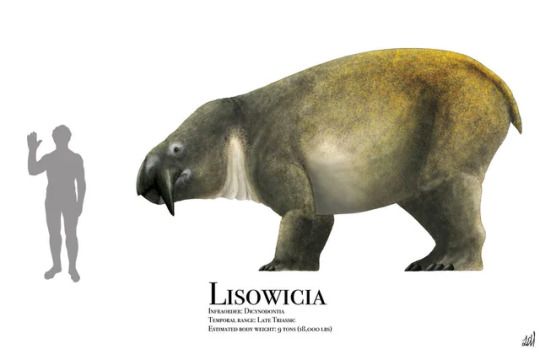
#paleontology#fossils#geology#science#science education#march madness#poland#england#prehistoric fish#dicynodont#late triassic#jurassic period
8 notes
·
View notes
Text

0 notes
Text
Fossil Crocs of 2024
Another year another list of new fossil crocodilians that greatly expand our knowledge of Pseudosuchia across deep time. Happy to say that this is my third time doing this now, so I'm not going to bog you down with the details and get right into it.
Benggwigwishingasuchus
Our first entry, sorted by geological age of course, is Benggwigwishingasuchus eremicarminis (desert song fishing crocodile) from the Middle Triassic (Anisian) of Nevada. It was a member of the clade Poposauroidea, which some of you might recognize as also containing such bizarre early croc cousins like Arizonasaurus and Effigia. Also notable about Benggwigwishingasuchus is that it was found in the Fossil Hill Member of the Favret Formation. Why is that notable? Well the Fossil Hill Member preserves an environment deposited 10 km off the Triassic coastline and also yielded fossils of animals like Cymbospondylus, the giant ichthyosaur. Despite this however, Benggwigwishingasuchus shows no obvious signs of having been a swimmer or diver. Instead, its been hypothesized that it was simply foraging around the coast and might have been washed out to sea.
Artwork by Joschua Knüppe (@knuppitalism-with-ue) and Jorge A. Gonzalez
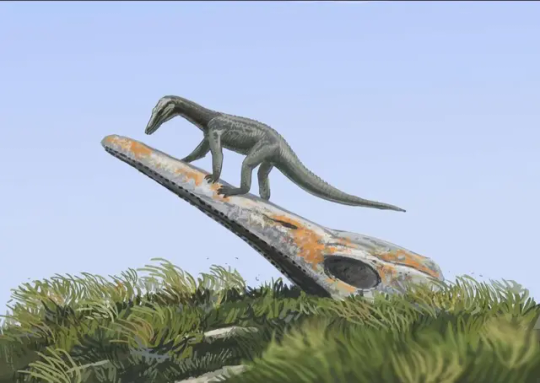
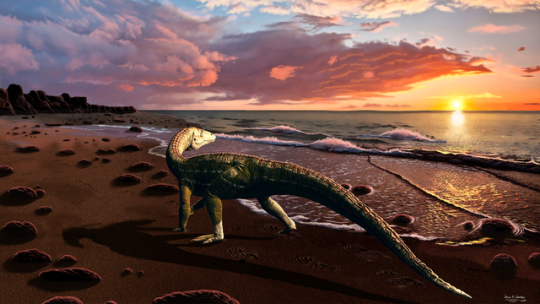
Parvosuchus
Fast forward some 5 million years to the Ladinian - Carnian of Brazil, specifically the Santa Maria Formation. Here you'll find the one new genus on the list I did not write the wikipedia page for: Parvosuchus aurelioi (Aurélio's Small Crocodile). With only a meter in length, Parvosuchus is amongst the smallest pseudosuchians of the year and a member of the aptly named Gracilisuchidae. Santa Maria was actually home to multiple pseudosuchians, including the mighty Prestosuchus (and its possible juvenile form Decuriasuchus), the small erpetosuchid Archeopelta and larger Pagosvenator and one more...
Artwork by Matheus Fernandes and Joschua Knüppe
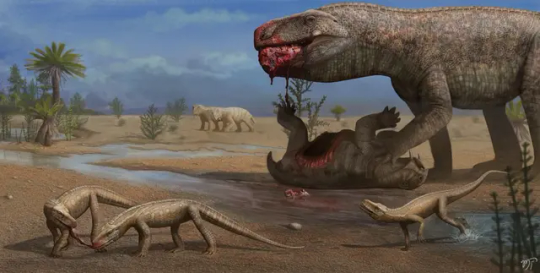

Schultzsuchus
Yup, Santa Maria has been eating good this year. Before the description of Parvosuchus, scientists coined the name Schultzsuchus loricatus (Schultz's Crocodile). Now this one's not entirely new and has long been known under the name Prestosuchus loricatus (by which I mean since 1938). What's interesting is that this new redescription suggests that rather than being a Loricatan, Schultzsuchus was actually an early member of Poposauroidea like Benggwigwishingasuchus. Even if it was no longer thought to be close to Prestosuchus, it was liekly still a formidable predator and among the larger pseudosuchians of the formation.
Artwork by Felipe Alves Elias

Garzapelta
Our last Triassic pseudosuchian and our only aetosaur of the year came to us in the form of Garzapelta muelleri (Mueller's Garza County Shield). It comes from the Late Triassic (Norian) Cooper Canyon Formation of, you guessed it, Garza County, Texas. As an aetosaur, the osteoderms are already regarded as diagnostic, tho unlike some other recent examples there is a little more material to go off from. It's still primarily osteoderms, but at least a good amount and even some ribs.
Artwork by Márcio L. Castro

Ophiussasuchus
Our only Jurassic newcommer is Ophiussasuchus paimogonectes (Paimogo Beach Swimmer Portuguese Crocodile), but arguably you couldn't find a better posterchild for Jurassic crocodyliforms. This new lad is a goniopholidid from the Kimmeridgian to Tithonian Lourinhã Formation, yup, Europe's Morrison. It's anatomy is perhaps not the most exciting, like other goniopholidids it had a flattened, very crocodilian-esque snout and was likely semi-aquatic like its relatives.
Artwork by @manusuchus and Joschua Knüppe


Enalioetes
Another quintessential group of Jurassic crocodyliforms are the metriorhynchoids, however, 2024's only new addition to this clade was actually Cretaceous, specifically from the earliest Cretaceous (Valanginian) of Germany. Like Schultzsuchus, Enalioetes schroederi (Schroeder's Sea Dweller) is new in name only, as fossil material has been found at the latest in 1918 and given the name Enaliosuchus "schroederi" in 1936. This kickstarted a whole series of taxonomic back and forth until the recent redescriptoin finally just gave it a new name and settled things (for now). Looking back I realize that I really need to take the time and fix up the Wikipedia page. Tho I've written its current status, I was kinda limited by being on vacation and never dived into the description section.
Artwork by Joschua Knüppe and Jackosaurus
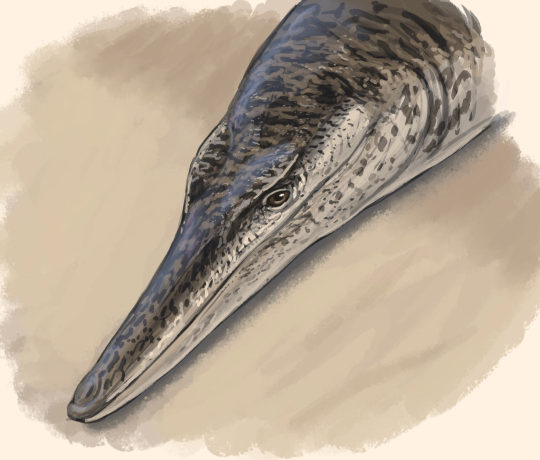

Varanosuchus
Another Early Cretaceous crocodyliform is Varanosuchus sakonnakhonensis (Monitor Lizard Crocodile from the Sakon Nakhon Province), described from Thailand's Sao Khua Formation. It lived around the same time as Enalioetes, but otherwise couldn't have been more different. Where Enalioetes was fully marine, Varanosuchus was more a land dweller as evidenced by the deep skull and long, slender legs. At the same time, some other features, like its more robust limbs compared to its kin, might suggest that Varanosuchus could have still spent some time in the water like some modern lizards. Tho one might be reminded of Parvosuchus from earlier, Varanosuchus is a much more recent example of small terrestrial croc-relatives, the atoposaurids, which are much closer to todays crocodiles and alligators.
Artwork once again by Manusuchus

Araripesuchus manzanensis
Yet another example of a small, gracile land "crocodile" comes to us in the form of Araripesuchus manzanensis (Araripe Basin Crocodile from the El Manzano Farm). And once again, it belonged to a completely different group, this time the notosuchian family Uruguaysuchidae. Now Araripesuchus is well known as a genus, in part due to the work of Paul Sereno and Hans Larsson (who popularized the names "dog croc" and "rat croc" for two species). Tangent aside, A. manzanensis is known from the upper layers of Argentina's Candeleros Formation, corresponding to the Cenomanian (earliest Late Cretaceous). The same locality also yielded A. buitreraensis, from which A. manzanensis can be distinguished on account of its blunt molariform teeth in the back of its jaw. This dentition, which corresponds to a durophageous diet of hardshelled prey, could explain how it coexisted with the related A. buitrensis at the same locality, allowing the two to occupy different niches. There is a neat little animation done for this animal you can watch here.
Artwork by Gabriel Diaz Yantén

Caipirasuchus catanduvensis
We're staying in South America but moving to Brazil's Adamantina Formation for our next entry: Caipirasuchus catanduvensis (Caipiras Crocodile from Catanduva). This one is a little more recent, tho the age of the Adamantina Formation is a bit of a mess far as I can tell, ranging anywhere from the Turonian to the Maastrichtian. One could also argue that C. catanduvensis is part of the "lanky small croc club" that Parvosuchus, Varanosuchus and A. manzanensis belong to, but I feel that the very short snout helps it stand out from that bunch more easily. Anyhow, Caipirasuchus catanduvensis is a member of Sphagesauridae, related to Armadillosuchus, and herbivorous. What's really interesting tho is that the internal anatomy suggests the presence of resonance chambers not unlike that of hadrosaurs, possibly suggesting that these animals were quite vocal. This could also explain why baurusuchids appear to have had very keen hearing.
Artwork by Joschua Knüppe and Guilherme Gehr
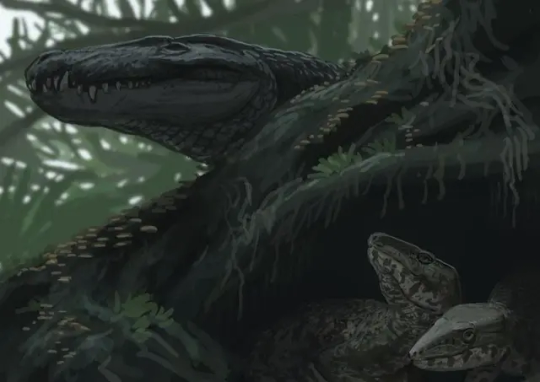

Epoidesuchus
We're staying in the Adamantina Formation for our last Mesozoic croc of the year, Epoidesuchus tavaresae (Tavares' Enchanted Crocodile). Tho also a Notosuchian like Araripesuchus and Caipirasuchus, this one belongs to the family Itasuchidae (or the subfamily Pepesuchinae depending on who you ask), which stand out as being rare examples of semi-aquatic members of this otherwise largely terrestrial group. Epoidesuchus was fairly large for its kin and had long, slender jaws. Like I said, Epoidesuchus and its relatives were likely more semi-aquatic than other notosuchians, something that might explain the relative lack of semi-aquatic neosuchians across Gondwana. They aren't absent mind you, but noticably rarer than they are in the northern hemisphere.
Artwork by Guilherme Gehr

And thus we move into the Cenozoic and towards the end our or little list. From here on out, say goodbye to Notosuchians or other weird crocodylomorphs and get ready for Crocodilia far as the eye can see.
Ahdeskatanka
The first Cenozoic croc we got is Ahdeskatanka russlanddeutsche (Russian-German Alligator), which despite its name comes from North Dakota, specifically the Early Eocene Golden Valley Formation. Ahdeskatanka is similar to many early alligatorines like Allognathosuchus in being small with rounded, globular teeth that suggest that it fed on hardshelled prey. This would have definitely helped avoid competition in the Golden Valley Formation, which also housed a second, similar form not yet named, a large generalist with a V-shaped snout similar to Borealosuchus and the generalized early caiman Chrysochampsa, also large but with a U-shaped snout.
Artwork by meeeeeeee

Asiatosuchus oenotriensis
We had an alligatoroid, so now its time for a crocodyloid. Asiatosuchus has been recognized from the Late Eocene Duero Basin of Spain for a while now, but now we have a name: Asiatosuchus oenotriensis (Asian Crocodile Belonging To The Land Of Wine). Asiatosuchus is a complex genus, most often not really forming a monophyletic clade and likely representing several distinct or at least successive taxa that form the "Asiatosuchus-like complex". Within this complex, A. oenotriensis is thought to have been close-ish to Germany's Asiatosuchus germanicus.
Artwork by Manusuchus

Sutekhsuchus
Rounding out the trio of major crocodilian clades is Sutekhsuchus dowsoni (Set's Crocodile/God of Deception Crocodile), representing our only gavialoid of the year. Originally described as Tomistoma dowsoni in 1920 based on fossil remains from the Miocene of Egypt, Sutekhsuchus has been at times regarded as distinct and at other times lumped into Tomistoma lusitanica. It was one of several early gavialoids to inhabit the coast of the Tethys during the Miocene and appears to have been most closely related to the genus Eogavialis, clading together just outside of the American and Asian gharials. A fun little personal anecdote, I prematurely learned about this one due to a friend highlighting the name in a study on Eogavialis. Never having heard of "Sutekhsuchus" I took to google scholar, where I found a single result: a reference to the then unpublished description, which naturally I ended up eagerly awaiting.
Artwork by Manusuchus and Joschua Knüppe
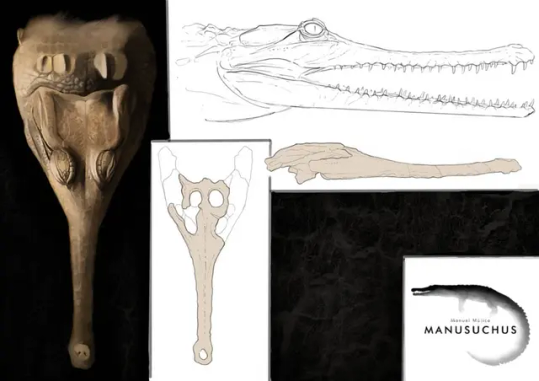
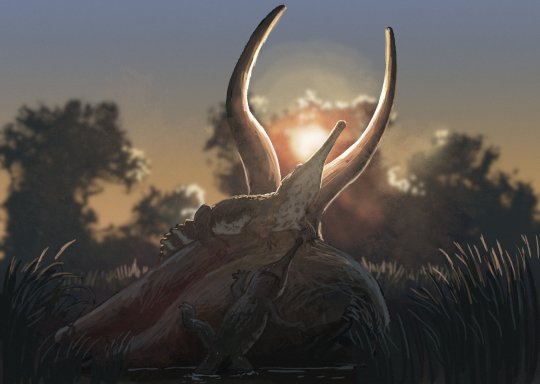
Paranacaiman
Two more and we're done. First, completely arbitrarily, Paranacaiman bravardi (Bravard's Caiman from Parana) from the Miocene Ituzaingo Formation of Argentina. Material of this genus has originally been referred to Caiman lutescens, described in 1912 but now considered a nomen dubium. Paranacaiman is known from limited material only, just the skull table, but that would indicate a "huge" animal. My personal scaling recovered a size of almost 5 meters in length, similar to large black caimans today.
Once again, credit to me

Paranasuchus
Last but not least, Paranasuchus gasparinae (Gasparini's Crocodile from Parana). Coming from the same deposits as Paranacaiman, this one too has been known as a species of Caiman for some time before being assigned its own genus, though it at least got to retain its old species name. Alas, I have not scaled it myself, tho its material is at least more extensive than that of Paranacaiman, including even parts of the snout. A little nitpick because I don't have much to say, but I personally think the name was ill conceived. On its own both Paranacaiman and Paranasuchus are fine names don't get me wrong, but together, coined by the same authors in the same study no less, they strike me as needlessly confusing to non experts. Both are caimans, both are from Parana, so the distinction between "Parana Caiman" and "Parana Crocodile" is entirely arbitrary and doesn't really distinguish them. Not helped by the fact that they are even closely related in the original description. Other than that tho another good addition to our understanding of fossil crocs.
No artwork on this one, but fossil material from Bona et al. 2024

And that wraps up 2024. I hope This post, or my posts throughout the year or even my work on Wikipedia has helped to make these fascinating animals just a little bit more approachable and a massive thanks to all the artists who took their time to create fantastic pieces featuring these incredible animals. Special shout outs to Manusuchus, who diligently illustrated a lot of the featured animals and Joschua Knüppe, who had to listen to me suggest Ahdeskatanka every Sunday for about two months straight now.
Fossil Crocs of 2023
Fossil Crocs of 2022
#paranasuchus#paranacaiman#ahdeskatanka#sutekhsuchus#ophiussasuchus#epoidesuchus#caipirasuchus#araripesuchus#enalioetes#parvosuchus#benggwigwishingasuchus#schultzsuchus#garzapelta#varanosuchus#paleontology#prehistory#palaeoblr#long post#fossil crocs of 2024#paleo#paleonotlogy#crocodilia#crocodylomorpha#pseudosuchia#fossils#2024
260 notes
·
View notes
Text

Species of Ichthyosaur Is Largest Known Marine Reptile at 80 Feet Long
A father and daughter duo found the jawbone of the species and the research team named the new marine reptile species Latin for 'giant fish lizard of the Severn.'
A father and daughter, searching for fossils on an English beach, found more than they expected: the jawbone of what may be the largest known marine reptile. Scientists estimate that the giant ichthyosaur, from which the jawbone came, measured 80 feet long and lived during the late Triassic period. A report in the journal PLOS details the find. When Justin Reynolds and Ruby Reynolds (then 11) were combing the beach at Somerset in 2020 and came upon a giant bone chunk, they knew they were on to something. “When Ruby and I found the first two pieces we were very excited as we realized that this was something important and unusual,” said Reynolds in a release. So they contacted Dean Lomax, a University of Manchester paleontologist...
Read more: https://www.discovermagazine.com/the-sciences/species-of-ichthyosaur-is-largest-known-marine-reptile-at-80-feet-long
204 notes
·
View notes
Text
Round 3 - Chondrichthyes - Chimaeriformes




(Sources - 1, 2, 3, 4)
Our last order in Chondrichthyes is Chimaeriformes, commonly known as “Chimaeras”, and informally known as “ghost sharks”, “spookfish”, “rabbitfish”, or “rat fish” (not to be confused with the Actinopterygiian “rattails”.) Historically a much more diverse and abundant group, they now only comprise the living families Callorhinchidae (“plough-nosed chimaeras” or “elephantfish”), Chimaeridae (“short-nosed chimaeras”), and Rhinochimaeridae (“long-nosed chimaeras”).
Chimaeras are soft-bodied, with bulky heads and long, tapered tails. Their pectoral fins are large enough to generate lift at a relaxed forward momentum, similar to a kite, giving the chimaera the appearance of "flying" through the water. Their gill arches are condensed into a pouch-like bundle covered by an operculum with a single gill-opening in front of the pectoral fins, similar in appearance to Actinopterygiians. They lack spiracles. There are two dorsal fins: a large triangular first dorsal fin and a low rectangular or depressed second dorsal fin. For defense, some chimaeras have a venomous spine on the front edge of the dorsal fin. In many species, the bulbous snout is modified into an elongated sensory organ, capable of electroreception to find prey. Instead of many sharp, consistently-replaced teeth, chimaeras have just six large, permanent tooth-plates, which grow continuously throughout their entire life. These tooth-plates are arranged in three pairs, with one pair at the tip of the lower jaws and two pairs along the upper jaws. They together form a protruding, beak-like crushing and grinding mechanism, comparable to the incisor teeth of rodents and lagomorphs. Most living species are native to the deep sea, with some species inhabiting depths exceeding 2,000 m (6,600 ft) deep, though the few exceptions include the shallower-dwelling plough-nosed chimaeras (genus Callorhinchus) (image 2), the Rabbit Fish (Chimaera monstrosa), and the Spotted Ratfish (Hydrolagus colliei) (image 3).
Chimaeras have separate anal and urogenital openings, rather than a single cloaca. Like sharks and rays, male chimaeras utilize claspers for internal fertilization of females, but unlike sharks and rays, also have retractable sexual appendages known as tentacula to assist in mating. The frontal tentaculum, a bulbous rod which extends out of the forehead, is used to clutch the females' pectoral fins during mating. The prepelvic tentacula are serrated hooked plates normally hidden in pouches in front of the pelvic fins, and they anchor the male to the female. Their claspers are fused together by a cartilaginous sheathe before splitting into a pair of flattened lobes at their tip. Females lay their eggs within spindle-shaped, leathery egg cases which they deposit on the sea floor.
As the most ancient of the Chondrichthyans, Chimaeriformes are truly deserving of the moniker “living fossil”. They have been around since the Early Carboniferous, with the earliest known fossil species being Protochimaera, and split off from the sharks and rays during the Devonian. Modern chimaeras are known from the Early Jurassic, but fossil egg cases from the Late Triassic resembling those of rhinochimaerids and callorhinchids indicate that they had a global distribution earlier than this. Modern chimaeras reached their highest ecological diversity during the Middle Cretaceous. Recent studies indicate that chimaeras were likely a shallow-water group for most of their existence, and only fled to deeper waters in the aftermath of the K-Pg extinction event, adapting to the deep sea to survive.

Propaganda under the cut:
Some chimaera venom can cause pain, necrosis, hallucinations, and localized paralysis in humans. It is not deadly to humans, but has been known to kill Harbor Seals that injested Spotted Ratfish (Hydrolagus colliei).
Spotted Ratfish (Hydrolagus colliei) have large, emerald green eyes, which are able to reflect light, similar to the eyes of a cat.
Chimaera teeth are unique among vertebrates, due to their mode of mineralization. Most of each plate is formed by relatively soft osteodentin, but the active edges are supplemented by a unique hypermineralized tissue called pleromin, rather than enamel. Pleromin is an extremely hard enamel-like tissue, arranged into sheets or beaded rods, but it is deposited by mesenchyme-derived cells similar to those that form bone. In addition, pleromin's hardness is due to the mineral whitlockite, which crystalizes within the teeth as the animal matures.
The Australian Ghostshark (Callorhinchus milii) is very popular with fish-and-chips restaurants in New Zealand and is sold as 'flake' or 'whitefish' in Australia.
The Striped Rabbitfish (Hydrolagus matallanasi) can see in total darkness and sense electromagnetic radiation (outside of the visible spectrum) emitted by other marine creatures due to exposed nerves on the sides of its body.
Some species of chimaerids are known to segregate by sex, with females congregating at greater depths than males.
Despite their deep sea habitat and reclusive nature, some chimaera species are still threatened by bycatch due to deep sea trawling for demersal shrimp and prawns. Even when released, most chimaeras do not survive the process of being quickly pulled up from the pressurized deep sea to shallower water.
#description a bit longer than usual because they’re so unlike all the other members of the class#animal polls#round 3#chondrichthyes
102 notes
·
View notes
Text
Fish of the Day
Today's fish of the day is the spotted gar!

The spotted gar, known by scientific name Lepisosteus oculatus, is a common North American freshwater fish. Found across the South and Midwestern sections of the country, the spotted gar has a range stretching from South of Ontario Canada, to the Northern Gulf of Mexico. In Longitude their range is from Devils river in Western Texas to Florida, with particularly notable populations in the great lakes and Florida rivers. Within this range they can be found around clear and slow moving rivers and lakes, although they will put up with saltier brackish water, and areas with low dissolved oxygen. Spotted gars in particular are known for hiding along the shoreline, where they use vegetation as a cover from larger predators. However despite their large range, their numbers have been dwindling. Previously large populations of spotted gars, once found in Illinois their numbers have dwindled due to increasing lack of clear waters and habitat destruction by humans.

Gars themselves are an incredibly old living fossil animal, having evolved into existence 240 million years ago, in the middle Triassic period, they can still be found almost exactly the same as they were back then. There are only 7 extant species nowadays, spread almost equally across two families. The spotted gar in particular belongs to the Lepisosteus genus in particular, which it shares with the Florida gar, longnose gar, and shortnose gar. It can be visually distinct from these family members by the spotting patterns along the mature gars dorsal side. Other than the Lepisoteus genus, there is the Atractosteus genus, which is known for their ability to better withstand marine conditions, being made up of the alligator gar, tropical gar, and Cuban gar. Gars can be identified by the armored scales around their body and thin knife-like mouth. All gar contain a swim bladder that can be repurposed as a lung temporarily when not in oxygenated water, similar to many other living fossil fish from around this same time period.

Focusing once more on just spotted gar, their diet consists of fast moving prey. Primarily minnows, bluegills, sunfish, and other small fish in their shared environments.Other than fish, the gars diet is made up of freshwater shrimp, learvae, and other crustacean invertebrates. This diet supports them getting to a length of 2-3 feet, relatively small compared to other gar. Other than acting as a predator though, the spotted gar is predated on by larger fish, alligator, and heron. The life cycle of the spotted gar is like that of all other gar. Spawning occurs in the months of late spring to early summer from April-June, depending on sufficient water temperatures (70 degrees or higher) and amount of vegetation. Females can lay up to 20,000 eggs in a single breeding season but on average lay only 13,000. Like many gar eggs, these are adhesive and toxic to predators, taking only 10-14 days before hatching. over 80% of all fry hatched will die in this stage. But, of those who survive, they will sexually mature at an age of 2-4 years old, with most only living to the ripe age of 8-10. Although, in captivity some spotted gar have lived as long as 18 years before meeting their end.

That's the spotted gar, everybody! Have a wonderful day!
#gar#sptted gar#spotted gar#Lepisosteus oculatus#fish#fish of the day#fishblr#fishposting#aquatic biology#marine biology#freshwater#freshwater fish#animal facts#animal#animals#fishes#informative#education#aquatic#aquatic life#nature#river#ocean
106 notes
·
View notes
Text
If you asked me as a kid what my favorite animal was, there's a good chance I'd respond "chambered nautilus", though I probably would mispronounce it. I don't know if it's still my favorite but it's definitely up there in the pantheon of weird critters. For this Wet Beast Wednesday, I'll discuss my childhood favorite.
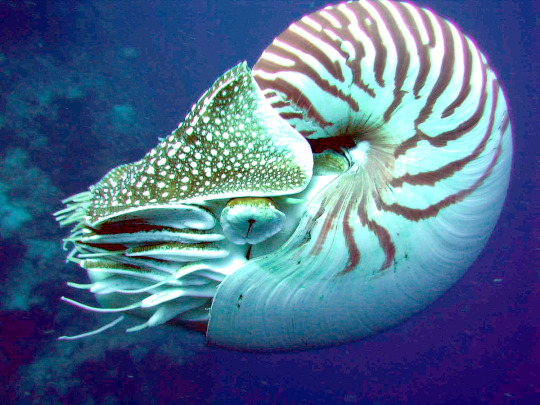
(image: a nautilus)
The nautilus is a cephalopod that lives in a curved shell and looks similar to (but is not closely related to) the extinct ammonites. There are 6 living species in two genera, but 90% of the time when someone is discussing nautiluses they are referring to the most well-known species: Nautilus pompilius or the chambered nautilus. Nautiloids are ancient, going back to at least the late triassic with their more primitive ancestors going back as far as the ordovician period, a time when only invertebrates and primitive plants occupied the land and true fish had not yet appeared. Because of their ancient history, nautiluses are sometimes considered living fossils. I have ranted before on how misleading the term "living fossil" is so I'll spare you that for now. Nautiloids are considered a sister group to the celoids, which contains all the squid, octopus, cuttlefish, and everything else we thinks of as cephalopods. Nautiluses should not be confused with paper nautiluses. Also called argonauts, paper nautiluses are a group of octopi that make an egg case which looks like a shell.
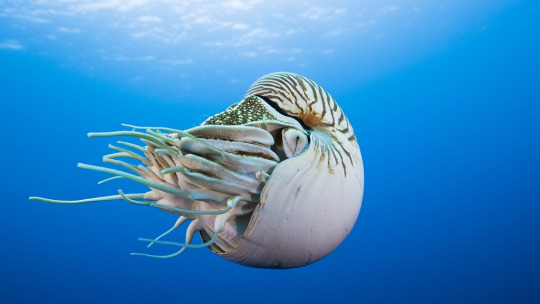
(image: a nautilus)
The most noticeable feature of a nautilus is its shell. The shell is smooth and finely curving, naturally growing in the shape of a logarithmic spiral (though not, as is commonly stated, a golden ratio spiral). The shell has a stripy outer layer and an inner layer coated with nacre. Internally, the shell is divided into camarae (chambers) separated from each other by walls called septa. Each septum has a small hole in it through which a strand of tissue called the siphuncle passes. Most of the nautilus's body is in the foremost and largest chamber. The shell grows new septa as the animal grows, with the nautilus's body moving to a new chamber as it becomes too large for previous ones. Juveniles are typically born with 4 septa, with adults having as many as 30. In addition to providing protection from predators, the shell is also key for regulating buoyancy. The septa can contain pressurized gas or water and the siphuncle regulates their contents by either adding or removing water to increase or decrease buoyancy. Because of its pressurized contents, the shell can only withstand pressure at depths up to 800 M (2,400 ft) before imploding. Oddly enough, nautiluses can be safely brought up from deep waters where most animals would be killed by the pressure changes. To move, the nautilus pulls water into the first chamber of the shell using its hyponome (siphon) and shoots it back out. The chambered nautilus is the largest species, with a maximum shell diameter of 25 cm (10 in), though most get no larger than 20 cm (8 in).
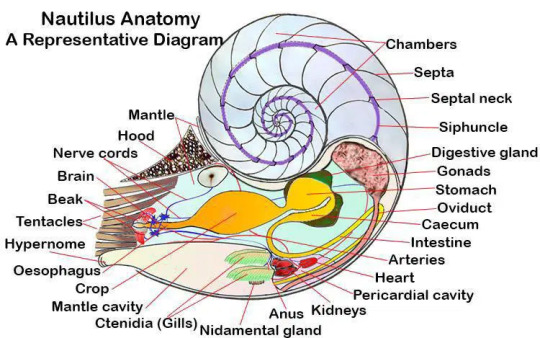
(image: a diagram of nautilus anatomy. source)
Where celoid cephalopods have tentacles, nautiluses instead have numerous cirri. Unlike tentacles, cirri are less muscular, are not elastic, and have no suckers. They are used to grab objects using their ridged surfaces and can hold in so hard that trying to take an object away from a nautilus can rip off its cirri, which will remain firmly attached. In addition, the nautilus has modified cirri that serve as olfactory receptors and a pair that serve to open and close the shell when the nautilus needs to retract into it or emerge. Nestled within the cirri is the beak, which is used to consume the nautilus's primary prey of invertebrates, though they have also been seen scavenging fish. Their eyes are less developed than most cephalopods, lacking a lens and consisting of a small pinhole that only allows the nautilus to see simple imagery. Their brains are differently structured than most cephalopods and studies have found them to have considerably shorter long-term memories.
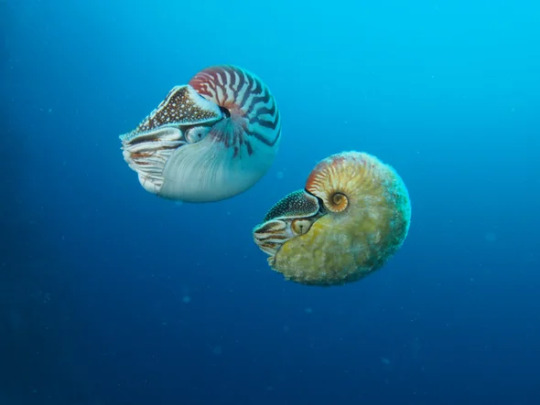
(image: a chambered nautilus (upper left) next to a rare Allonautilus scrobiculatus. source)
Cephalopod reproduction is quite different than that of other cephalopods. While most cephalopods are short-lived and semelparous (reproducing only once), nautiluses can live over 20 years and reproduce multiple times (iteroparity). They do not reach sexual maturity until around 15 years old, with females laying eggs once per year. Eggs are attached to rocks and take 8 to 12 months to hatch. Males have a structure called the spadix composed of 4 fused cirri that they use to transfer sperm to females. Females lose their gonads after laying their eggs and will regenerate them for the next year's mating season. Interestingly, male nautiluses seem to vastly outnumber the females. EDIT: @bri-the-nautilus in the replies found an alternate explanation for the disparity in male and female numbers you should check out. TLDR; the females are asocial.
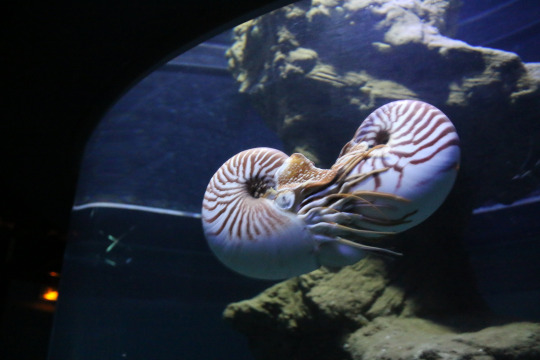
(image: nautiluses mating)
Nautiluses are found in the Indo-Pacific reagion of the ocean and can be found on the steep slopes of coral reefs. They prefer to inhabit waters several hundred meters down. It was once believed that they would rise to shallow waters at night to feed, lay eggs, and mate, but their vertical migration behavior has since been shown to be more complex than that. They have noon been fished by humans for their shells, which have become popular subjects in art and can be made into a number of decorative pieces. The nacre of the shell can be polished into osmeña pearl, which can be quite valuable. Demand for the shells combined with the late sexual maturity and low fecundity is threatening all the species. As of 2016, nautiluses have been added to the CITES Appendix II, making them protected by limiting international trade of their shells. Despite this, they are still threatened and require further protection

(image: a carved and painted nautilus shell from the Poldi Pezzoli Museum, Milan)
#wet beast wednesday#nautilus#chambered nautilus#cephalopod#marine biology#zoology#biology#ecology#animal facts
1K notes
·
View notes
Text
Archovember 2024 Day 27 - Tanystropheus longobardicus
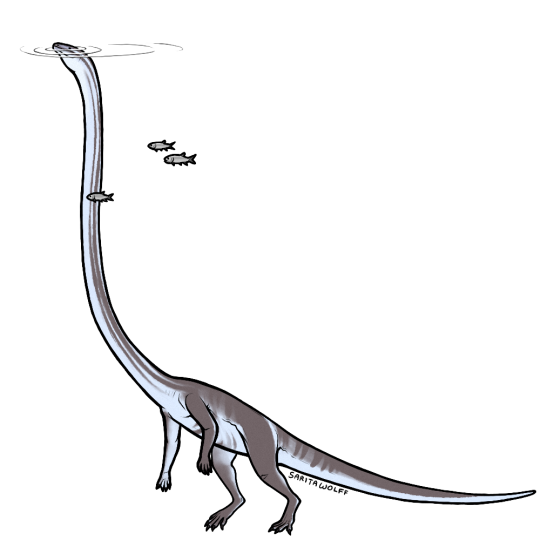
Our last non-archosaur archosauromorph of this Archovember (say that 5 times fast) is Tanystropheus longobardicus. This archosauromorph lived in the Middle Triassic of what is today the border of Italy and Switzerland. It’s most recognizable feature is its long neck, made up of 13 lengthened vertebrae, that stretched out longer than its body and tail combined! What it was doing with this long neck is the subject of debate. The neck was not very flexible, made of long, stiff vertebrae, though it was lightweight and stabilized by tendons. Tanystropheus was likely a fish-eater, with T. longobardicus in particular being equipped with three-cusped teeth suited for holding onto slippery prey, and fish scales and cephalopod hooklets have been found in the stomach region of some specimens. Its body did not seem to have many adaptations for swimming, though its muscular hindlimbs and tail may have allowed for short bursts of active swimming in shallow water. It’s hypothesized that Tanystropheus was a semi-aquatic ambush predator, either using its long neck to reach across the water and snap up fish like a heron, or waiting in the water like a turtle, its body unseen and long neck appearing like an innocent branch.
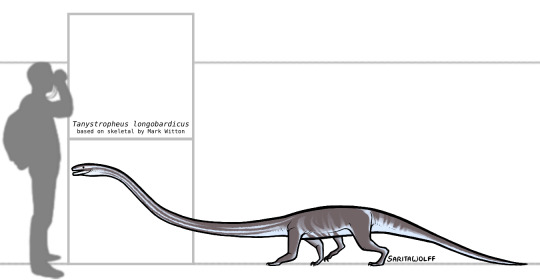
Tanystropheus longobardicus was the smallest of the known species of Tanystropheus. It lived alongside the larger, bulkier T. hydroides, while even larger Tanystropheus specimens have been found in Germany and Poland. Fossils have also been found in Canada and China, meaning this genus may have had a worldwide distribution. But T. longobardicus in particular lived in the Besano Formation. It was set apart from the larger T. hydroides by its small size, narrow triangular head, and tricuspid teeth in the back of its skull. Meanwhile, the larger T. hydroides had a broader skull and long interlocking fangs. The two species likely did not compete, as T. hydroides would have preferred much larger fish than T. longobardicus. But these were not the only tanystropheids in the Bessano Formation. They would have also lived alongside the smaller, shorter-necked, terrestrial tanystropheid Macrocnemus bassanii. On land, Tanystropheus longobardicus would have had to worry about the early rauisuchian Ticinosuchus. In the sea, Tanystropheus would have had to look out for the nothosaur Nothosaurus, large thalattosaurs like Askeptosaurus, large predatory fish like Birgeria, and even large icthyosaurs like Besanosaurus and Cymbospondylus. It may have also come across smaller icthyosaurs like Mixosaurus, Phalarodon, and Wimanius, as well as placodonts like Cyamodus and Paraplacodus, pachypleurosaurs like Serpianosaurus and Odoiporosaurus, and other reptiles like Silvestrosaurus, Helveticosaurus, and Eusaurosphargis. It could have eaten small fish like Aetheodontus, Cephaloxenus, and Luganoia, and even small coelocanths like Ticinepomis.

This art may be used for educational purposes, with credit, but please contact me first for permission before using my art. I would like to know where and how it is being used. If you don’t have something to add that was not already addressed in this caption, please do not repost this art. Thank you!
#Tanystropheus longobardicus#Tanystropheus#tanystropheid#archosauromorphs#reptiles#Archovember#Archovember2024#Dinovember#Dinovember2024#SaritaDrawsPalaeo#Middle Triassic#Italy#Switzerland#Bessano Formation
56 notes
·
View notes
Text

Relics of a Red World in Bighorn Basin
During the Triassic Period, about 220 million years ago, the present-day continent of North America was part of the supercontinent Pangea. Commensurate with Pangea’s tremendous size, its weather patterns also achieved large scales. Scientists think the tropical zones of this giant landmass experienced “megamonsoons” in this period, setting up fluctuations between extreme wet and dry seasons.
These cycles of wetting and drying are believed to have oxidized, or rusted, sediments across vast areas. The resulting rock layers, commonly referred to as “red beds,” take their color from the mineral hematite and now appear on several continents. In North America, the rusted Triassic rocks show up in a handful of places, including Bighorn Basin in northern Wyoming and southern Montana. This oval-shaped basin, approximately 150 miles (240 kilometers) long and 80 miles (130 kilometers) wide, is encircled by six mountain ranges and is rich in both fossils and oil and gas reservoirs.
Sharp folds of the distinct reddish Chugwater Formation cut across the image above, acquired with the OLI-2 (Operational Land Imager-2) on Landsat 9 in June 2024. In the tens of millions of years since the Chugwater’s Triassic conception, the Pangean supercontinent fragmented, and landmasses recombined. The sedimentary rock layers seen here were folded and tilted in the continental collisions that created the Rocky Mountains. These folds are located near the northern end of Bighorn Basin; other outcrops of the Chugwater appear in the basin, often along its perimeter.

This jagged streak of red rock intersects with Bighorn Canyon. The canyon makes a gouge in the landscape as it extends north into Montana, with depths reaching up to 2,500 feet (760 meters). Bighorn Canyon National Recreation Area, outlined in the image above, was established in 1966 after the Bureau of Reclamation constructed Yellowtail Dam on the Bighorn River and created a lake more than 70 miles (110 kilometers) long.
The recreation area encompasses a wide range of natural and cultural wonders. Researchers have discovered fossils dating back to the Jurassic Period within its boundaries. Today, the shrubland, woodland, and steppe habitats are home to wildlife such as bighorn sheep, wild horses, and coyotes. Artifacts along parts of the Bad Pass Trail, traveled by Native Americans for thousands of years, are preserved within the park. Now, more than 200,000 people visit the area each year for hiking, boating, fishing, and other activities.
NASA Earth Observatory images by Wanmei Liang, using Landsat data from the U.S. Geological Survey. Story by Lindsey Doermann.
6 notes
·
View notes
Photo

Fossil Fish Tooth – Upper Triassic – Aust Cliff, Westbury Formation, Bristol UK – Genuine Specimen
Fossil Fish Tooth in Matrix – Upper Triassic – Aust Cliff, Westbury Formation, Penarth Group, Bristol, UK
This listing features an authentic fossil fish tooth preserved in matrix, originating from the iconic fossil-bearing bed at Aust Cliff, Bristol. This site is internationally recognised for its rich accumulation of fish, reptile, and coprolite remains from the Upper Triassic period, particularly within the Westbury Formation of the Penarth Group.
Geological & Scientific Context:
Locality: Aust Cliff, Bristol, UK
Stratigraphy: Westbury Formation, Penarth Group
Age: Upper Triassic (~205–210 million years ago)
Depositional Environment: A marginal marine estuarine or coastal lagoon setting with periodic anoxic conditions. These created ideal preservation conditions, capturing a moment in time from a biologically diverse late Triassic ecosystem.
Lithology: Laminated, organic-rich black mudstones with bone and tooth-rich concentrations
Fossil Description & Features:
The specimen displays a clearly defined fish tooth embedded within a natural matrix, offering a glimpse into the feeding anatomy of prehistoric fishes. Likely candidates for attribution include Saurichthys, Lepidotes, or Palaeoniscid fish—all of which are known from this formation.
Morphology:
Conical or lanceolate shape typical of piscivorous species
Smooth enamel surface, occasionally striated, with tapering to a fine point
Root occasionally visible, though often encased in matrix
Palaeontological Significance:
Teeth from this bed are essential in studying the evolution and dietary adaptations of early ray-finned fishes and predatory actinopterygians
The fossil record from Aust Cliff helps reconstruct the dynamics of Triassic vertebrate communities just before the major Jurassic radiation
Specimen Details:
Discovery Date: 07 April 2025
Discovered by: Our own field team members, Alister and Alison
Preparation & Treatment: Cleaned and stabilised by Alison
Scale Reference: Shown with 1cm cube – please refer to photographs for full sizing and angles
Authenticity: Comes with a Certificate of Authenticity – all of our fossils are 100% genuine and responsibly sourced
What You See Is What You Get: The specimen in the photos is the exact item you’ll receive
Ideal For:
Fossil collectors, educational purposes, museum displays, or anyone with a fascination for marine vertebrates of the prehistoric world. This specimen makes a superb addition to collections focused on Triassic ecosystems, vertebrate paleontology, or evolutionary biology.
#fossil fish tooth#Triassic fish fossil#Aust Cliff fossil#Upper Triassic fossil#Westbury Formation#Penarth Group#fossil fish remains#UK fossil fish#authentic fossil#prehistoric fish tooth#ancient fish jaw#reptile coprolite bed#vertebrate paleontology#real fossil tooth#certificate of authenticity
0 notes
Text
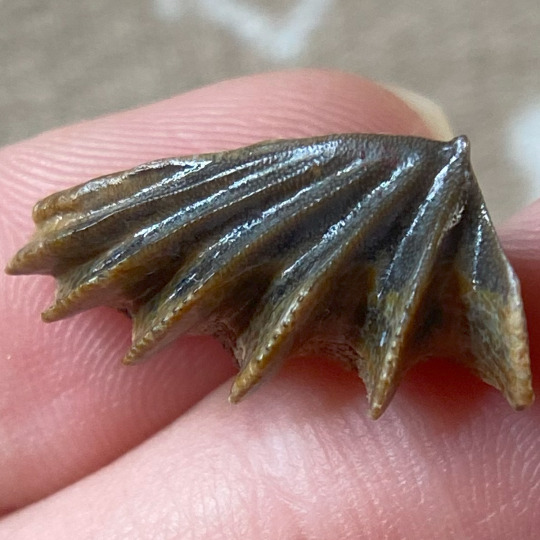
A Triassic lungfish tooth plate of an Arganodus dorotheae from the Bull Canyon Formation in Quay County, New Mexico, United States. Arganodus has sometimes been synonomized with the genus Asiatoceratodus.
#fish#lungfish#dipnoi#fossils#paleontology#palaeontology#paleo#palaeo#arganodus#asiatoceratodus#arganodontidae#asiatoceratodontidae#triassic#mesozoic#prehistoric#science#paleoblr#アルガノドゥス#アジアトケラトドゥス#ハイギョ#アルガノドゥス科#アジアトケラトドゥス科#化石#古生物学
37 notes
·
View notes
Text
Early Mesozoic burst of morphological disparity in the slow-evolving coelacanth fish lineage
Published 13th July 2023
A newly identified species of stem coelacanth, Rieppelia heinzfurreri, based on mid 20th century specimens.

Rieppelia heinzfurreri holotype and skeletal reconstruction

Juvenile or newborn specimen of Rieppelia heinzfurreri
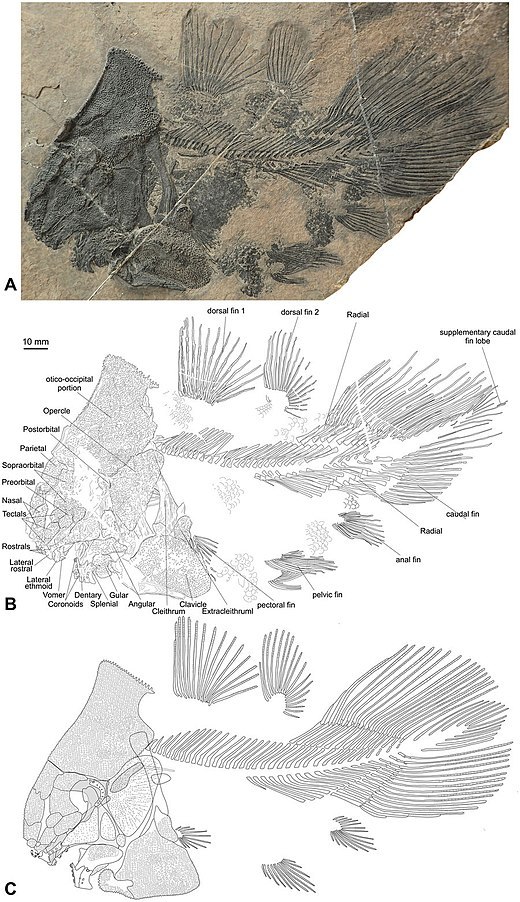
Fossil and illustration of the skeleton of Foreyia maxkuhni, from
Rieppelia heinzfurreri and Foreyia maxkuhni are closely related and share the same family
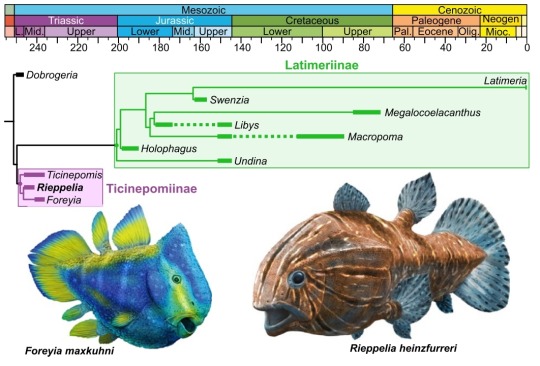
Time-tree phylogeny of Latimeriidae with reconstructions of Foreyia and Rieppelia, Artwork by Alain Bénéteau.
Source:
113 notes
·
View notes
Text
In the spring of last year, I made several color reconstructions of marine reptiles for a thesis and presentation (it was about the reconstruction of marine reptiles) for a conference that was held in Ulyanovsk in September. The drawings were done in ballpoint pen (lineart) and Paint Tool Sai 2.0 (shadows and colors).

The first is reconstruction of Mixosaurus cornalianus, a widespread small Triassic ichthyosaur. I had already drawn a Mixosaurus in water earlier and even wanted to use it in the article, but later changed my mind, deciding that lateral reconstruction would better convey the appearance of soft tissues. This earlier drawing can bee seen here:

Both pieces are based on the fin impressions described in 2020 from a specimen found in the Middle Triassic rocks of the Bezano formation, Italy (www.researchgate.net/publicati…). This specimen has preserved the tissues of the dorsal and caudal fins. Both prints have thin collagen filaments, and at the base of the caudal fin, it was possible to detect the remains of smooth, scaleless skin. The fins have a triangular shape, and the dorsal one is associated with 15-23 trunk vertebrae. In other words, its position turned out to be more
forward then in reconstructions done before his paper.

The second is lateral reconstruction of the metriorhynchid Cricosaurus albersdoerferi, belonging to a widespread genus that inhabited the shallow seas of future Europe, Central America and Argentina. It was not a particularly large animal, reaching from 2 to 3.2 meters in length. Like the first reconstruction of a Cricosaurus, which I performed in the spring, this drawing is based on a specimen that preserved a large volume of soft tissue on the tail (upload.wikimedia.org/wikipedia…). Also shown here is the salt gland in the antorbital fenestra, the presence of which was previously indicated in Cricosaurus araucanensis and Dakosaurus andiniensis. The spring work with C. albersdoerferi can be seen below:
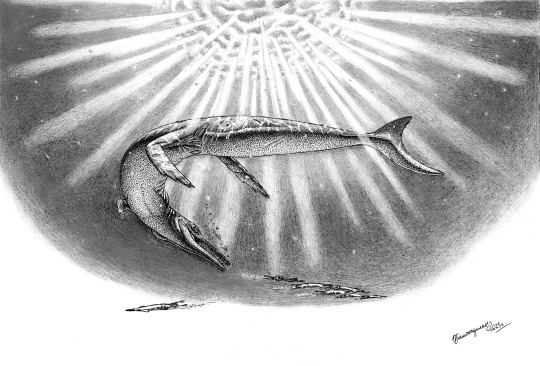

Plesiosaurs are mentioned too. This is reconstruction of the polycotylid Mauriciosaurus fernandezi from the Late Cretaceous of Mexico. A complete reptile skeleton preserved in fine-grained rocks was described by a team of paleontologists in 2017: www.researchgate.net/publicati… There are five types of soft tissue imprints around the bones. Among them are dark material, probably left from the walls of the peritoneum, dark gray traces of blubber and impressions of possible small scales. The impressions show that the animal's belly was covered with rectangular scales, which were mixed with inclusions of small fragments closer to the limbs. The scales of the living reptile were almost indistinguishable, so that the skin looked smooth. This beautifully preserved specimen showed that plesiosaurs had much more soft tissue than previously thought. The tail was especially fleshy. Fat deposits created a smooth, streamlined shape, ideal for an agile swimmer.
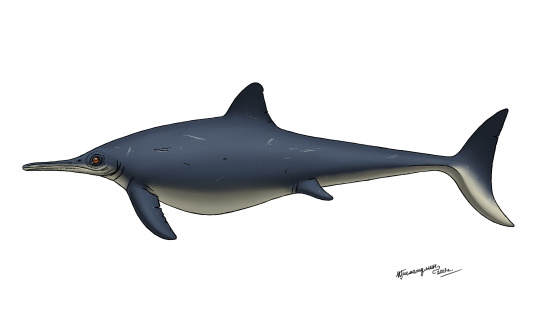
The last thesis drawing is this reconstruction of the famous Early Jurassic ichthyosaur Stenopterygius quadriscissus. Many of its skeletons of amazing preservation were found in the fine-grained limestones of Holzmaden, Germany. Some of them were discovered back in the 19th century, which made it possible to quickly correct previous ideas about ichthyosaurs. The Stenopterygius specimens retained soft tissue prints in the form of a bacterial film, which made it clear that they were fish-like creatures with a dorsal fin and a crescent tail. They re still attract the attention of researchers. In 2018, the skin structure of one partial specimen was studied: www.researchgate.net/publicati… A fossilized blubber was described, similar in microstructure to that of marine mammals and leatherback turtles. This led to the conclusion that ichthyosaurs were reptiles with a high metabolism, which required fat insulation. Blubber allowed ichthyosaurs to travel across the oceans, swimming even into the cold polar waters. In addition, this Stenopterygius had pigment cells - melanophores. They were absent on the ventral side, which means that the Stenopterygius had a dark back and a light belly. This countershading coloring is typical of today's marine vertebrates and serves as a camouflage.
I did also three works in fully traditional style, with pens and pencils, but I'll show them in the separate post. :)
#mixosaurus#stenopterygius#ichthyosaurs#cricosaurus#metriorhynchidae#mauriciosaurus#polycotylidae#plesiosaur#mesozoic marine reptiles#paleoart
31 notes
·
View notes
Text

#Archovember Day 24 - Araripesuchus wegeneri
The notosuchians were were such a diverse group of pseudosuchians you’d think they came from the Triassic. But no, this group of “mammal-mimicking” crocodylomorphs lived during the Jurassic and Cretaceous. One such Cretaceous notosuchian was Araripesuchus. This genus was widespread across the Southern Hemisphere, represented by at least 6 different species, mostly identified by their unique teeth. Today’s species is Araripesuchus wegeneri, the “Dog Croc.”

Living in Early Cretaceous Niger, Araripesuchus wegeneri appeared to be an omnivore, eating both plants and insects like grubs. Its common name “Dog Croc” is a reference to not only the dog-like shape of its skull, but also its unique caniniform teeth. Araripesuchus wegeneri fossils were found in a block with five skeletons packed together, so they may have even been social. All species of Araripesuchus had large eyes and thin osteoderms covering their body. They were likely more agile on land than in water, due to their long limbs. It could have possibly used its long legs to sprint to the water in order to flee predators, then used its muscular tail to swim.
There was a significant amount of pseudosuchian diversity in the Elrhaz Formation. Araripesuchus wegeneri would have lived alongside the similarly sized, duck-billed notosuchian Anatosuchus. It would have had to look out for the giant “Super Croc”, Sarcosuchus (perhaps the reason it had adapted for leaving the water so easily!) It would have also lived alongside the long-snouted fish-eater Stolokrosuchus. There were dinosaurs here as well, such as the iguanodont Lurdusaurus, the hadrosaur Ouranosaurus, the carcharodontosaurid Eocarcharia, the abelisaurid Kryptops, the spinosaurid Suchomimus, and the duck-billed sauropod Nigersaurus.
#my art#SaritaDrawsPalaeo#Araripesuchus wegeneri#Araripesuchus#notosuchians#pseudosuchians#archosaurs#archosauromorphs#reptiles#Archovember#archovember2023
13 notes
·
View notes